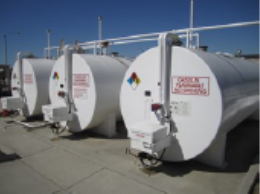The Aboveground Petroleum Storage Act (APSA) applies to owners and operators with a total storage capacity of 1320 gallons or more of petroleum at a facility. The City of Riverside Fire Prevention Division is responsible for the regulatory inspections of all tank facilities subject to APSA in the City of Riverside. The main purpose of the APSA inspection program is to verify tank facilities have prepared and are implementing a Federal Spill Prevention, Control, and Countermeasure (SPCC) Plan.

Some facilities with less than 1320 gallons of petroleum with a tank in an underground area (TIUGA) would be subject to APSA.
Who is Regulated?
A tank facility is regulated under APSA if
- Tank facility has a storage capacity of 1,320 gallons or more of petroleum.
- Tank facility has one or more tanks meeting the definition of a “tank in an underground area”
- Tank facility is subject to the federal SPCC rule specified in the Code of Federal Regulations, Title 40, Part 112
What is Required
Tank facilities pay an annual APSA fee to the Unified Program Agency (UPA) and file an annual tank facility statement or a Hazardous Materials Business Plan electronically into the California Environmental Reporting System (CERS)
Additionally, each owner or operator of a tank facility must prepare and implement an SPCC Plan that meets federal requirements. Facilities regulated under the ASPA program will be classified into one of three categories based on the largest container size and the total accumulation quantity stored onsite.
Tier I Facilities
Facilities must meet the following criteria to be considered APSA Tier I facilities:
- Must have capacity to store no more than 10,000 gallons of oil
- Must have no single container with a capacity larger than 5,000 gallons
- Must have no single discharge to navigable waters or adjacent shorelines exceeding 1,000 gallons and no two discharges, each exceeding 42 gallons within any 12-month period in the past three years.
Tier I facilities may use the EPA-designed template and may self-certify their Plan.
Tier II Facilities
Facilities must meet the following criteria to be considered APSA Tier II facilities:
- Must have capacity to store no more than 10,000 gallons of oil
- Must have a single tank or container with a capacity to store greater than 5,000 gallons
- Must have no single discharge to navigable waters or adjacent shorelines exceeding 1,000 gallons and no two discharges, each exceeding 42 gallons within any 12-month period in the past three years.
Tier II facilities may use the CalCUPA Forum Board designed template and may self-certify their Plan.
Full-Plan Facilities
Facilities that have the capacity to store more than 10,000 gallons of petroleum-based products above ground are considered to be full-plan facilities. These facilities must develop a full SPCC Plan. The Plan must be certified and stamped by a Professional Engineer and be approved by the facility or corporation management.
Tanks in Underground Areas (TIUGAs):
On October 2,015 Senate Bill SB-612 amended the definition of a “tank in an underground area” (TIUGA). Under APSA, aboveground storage tanks include TIUGAs if certain conditions are met. These conditions include but are not limited to: the storage tank is stationary, the storage tank is located on or above the surface of the floor in a structure at least 10 percent below the ground surface, and the structure in which the storage tank is located must allow for direct viewing of the exterior of the tank.
Facilities with less than 1320 gallons of petroleum are also regulated under APSA if it has one or more TIUGAs; in this case, only the TIUGAs are subject to APSA.
APSA Guidance (navigation links can be on left side of page or at bottom)
APSA Fees
| Category I - $713.00 | |
| Less than 10,000 gallons | |
| Category II - $893.00 | |
| Between 10,000 and 100,000 gallons | |
| Category III - $1074.00 | |
| More than 100,000 gallons |

